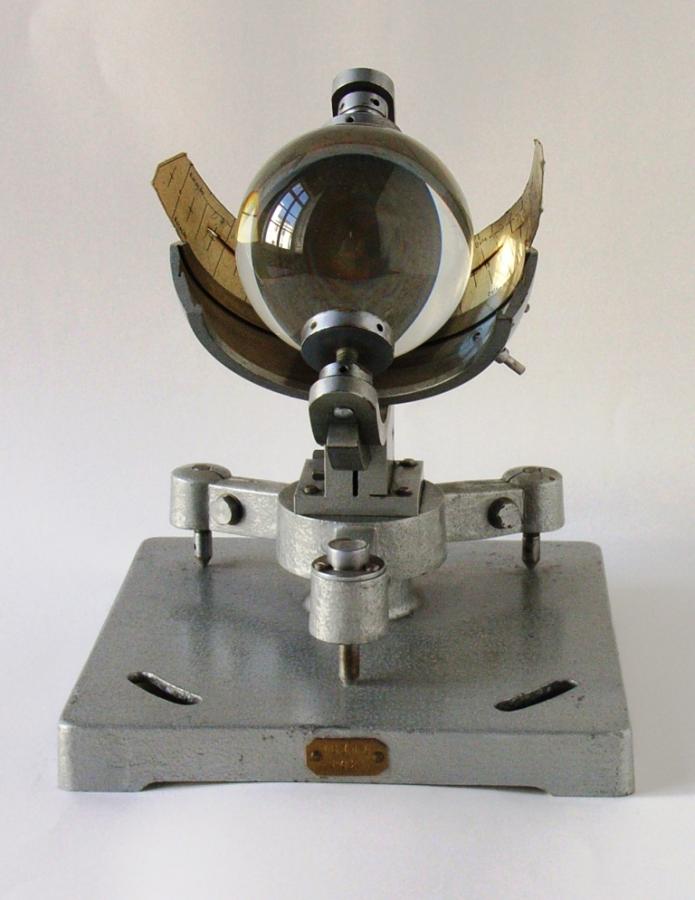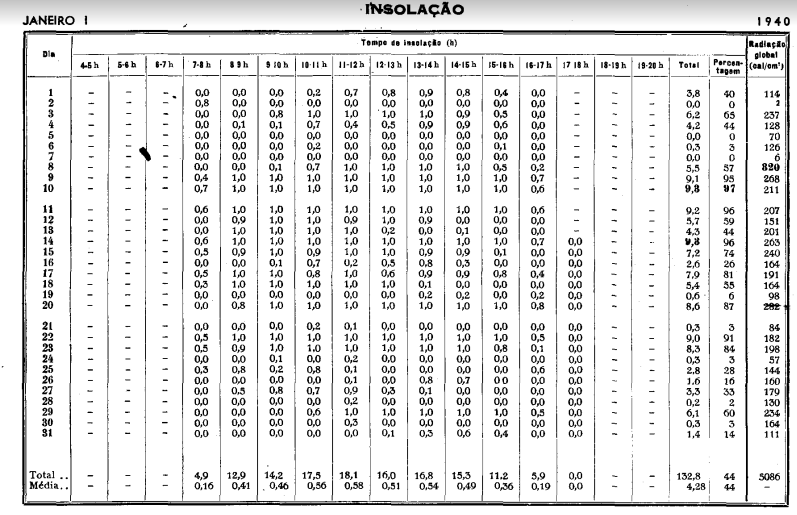
Objeto do mês
Este mês damos destaque ao Heliógrafo de Campbell-Stokes, proveniente do Instituto Geofísico do Infante D. Luiz e incorporado nas coleções do Museu em 1991. É um instrumento meteorológico de registo contínuo e serve para registar o número de horas de sol durante 1 dia – insolação. É constituído por uma armação que rodeia uma esfera de vidro cristalino onde se colocam tiras de cartão especiais.
As tiras são queimadas à medida que os raios solares se concentram num foco único. Com o movimento aparente do Sol, os raios solares deixam uma linha contínua ou descontínua na tira de insolação, conforme o Sol está descoberto ou coberto. Há três posições para colocar as tiras na armação de acordo com a estação do ano: inverno; primavera e outono; verão. Do mesmo modo há 3 formatos diferentes para as tiras que correspondem às estações do ano. No objeto deste mês, a tira está colocada para a posição de inverno.

As tiras têm uma escala horária, dividida ainda numa escala de meias-horas e devem ser colocadas seguindo o Tempo Solar Verdadeiro (TSV). O TSV difere do Tempo Universal (TU), que antigamente se chamava Tempo Médio de Greenwich (TMG), e está tabelado pelo Observatório Astronómico da Ajuda, variando com o dia do ano. Por exemplo, no dia 1 de fevereiro de 2023, as 9h TSV ocorrem às 9h 50min 17seg TU (09:50:17 TU). Na colocação da tira, o Meio Dia Solar Verdadeiro deve estar alinhado com a marca indicada no heliógrafo.
Na estação meteorológica de Lisboa/Instituto Geofísico do Infante Dom Luiz, inaugurada em 1853, fazem-se medições de insolação desde 1890 até aos dias de hoje, e tem, atualmente, a funcionar no seu parque de instrumentos, um outro heliógrafo muito semelhante ao objeto em destaque este mês. Nesta estação, a tira é mudada às 9h TSV. O heliógrafo está colocado no terraço da antiga torre da Física e tem que estar virado para Sul, de acordo com as normas da Organização Meteorológica Mundial (OMM). Esta estação pertence à rede internacional global de observações meteorológicas da WMO (com o número de identificação 08535) e as suas observações diárias e horárias são enviadas para o Instituto Português do Mar e da Atmosfera (IPMA). O IPMA remete depois os dados para o Centro Europeu de Previsão do Tempo (ECMWF) no Reino Unido, um dos principais centros de previsão meteorológica do mundo.

A insolação está relacionada com a radiação emitida pelo sol e que chega à superfície da Terra. Os dados de insolação são usados para estudos de climatologia e servem para avaliar o potencial de energia solar disponível como energia renovável. Pela análise dos dados de insolação observados na estação Lisboa/Geofísico conclui-se que por ano existem em média 2800 horas de sol, o que equivale a 62% do número máximo de horas de sol se não existissem nuvens.
HELIOGRAPH
This month we literally “shine a light” on the Campbell-Stokes Heliograph, that was used by the “Instituto Geofísico do Infante D.Luiz” and was included in the Museum’s collection in 1991. The heliograph is a meteorological instrument that continually marks the daily sunshine duration, i.e the number of sunshine hours within 1 day. It consists in a metal frame surrounding a crystal glass sphere where we can position specially prepared cardboard paper strips.
The strips are burnt as the solar rays passing through the crystal sphere concentrate on a single focus. As the Sun goes through its apparent movement, a continuous or discontinuous line is left on the paper strip, when the Sun is uncovered or covered by meteors (clouds, dust or fog). There are 3 different positions for the paper strips on the metal frame according to the season of the year: winter; spring and autumn; summer. Again there are 3 different strip shapes corresponding to the annual seasons. On the exhibited heliograph the strip is positioned on the winter part of the frame.
The strips contain an hourly scale, which is yet divided in half hours and must be set on the heliograph according to the “True” Solar Time. This Time is calculated according to the Earth’s ecliptic orbit around the Sun and differs from the Universal Time (UT), formerly called Greenwich Mean Time (GMT). The Solar Time is available from tables produced by the Observatório Astronómico da Ajuda in Lisbon and is different for each day of the year. For instance, on February 1st 2023 the 9:00 hours in “True” Solar Time correspond to the 9 hours 50 minutes and 17 seconds UT (09:50:17 UT). To correctly position the strip on the heliograph, the “True” Solar Noon line must be aligned with the respective heliograph’s engraved mark.
At the Lisbon/ Instituto Geofísico do Infante D. Luiz meteorológical station, inaugurated in 1853, sunshine duration has been registered since 1890 and measurements are still continuing nowadays. The instrument in use at the moment is also a Campbell-Stokes Heliograph, very similar to the one exhibited this month. In this station the solar strip is changed at 9:00 hours “True” Solar Time. The heliograph is positioned at the top of the terrace of the old Physics tower and is facing the South direction, according to the instruments rules issued by the World Meteorological Observation (WMO). This station belongs to the WMO international global observations network (with the WMO ID number 08535) and its hourly and daily observations are sent to the Instituto Português do Mar e da Atmosfera (IPMA) which then difuses the data to the European Centre for Medium Range Weather Forecast (ECMWF) in Reading, UK, one of the leading world centres of weather forecasts.
Sunshine duration is related to the solar radiation arriving at the Earth’s surface. Sunshine duration data are used in climatology studies and allow us to calculate the potential solar energy available as renewable energy. The data are also useful for agricultural purposes, to predict blooming periods in plants and insects cycles. In the Lisbon/Intituto Geofísico do Infante D. Luiz station there are around 2800 sunshine hours per year, the equivalente of 62% of the maximum number of sunshine hours with no clouds.
Texto de I Text by: Maria Antónia Valente, Instituto Dom Luiz - Faculdade de Ciência da Universidade de Lisboa
Fotografia de I Photo by: Vasco Teixeira
Fabricante I Maker: Campbell-Stokes. USA
Proveniência I Provenance: Instituto Geofísico do Infante Dom Luiz
MUHNAC-UL000366
PROGRAMA ALARGADO
16 fevereiro | 13h00
Visita à estação meteorológica do Instituto Dom Luiz
Visita orientada.
Inscrições:
geral@museus.ulisboa.pt